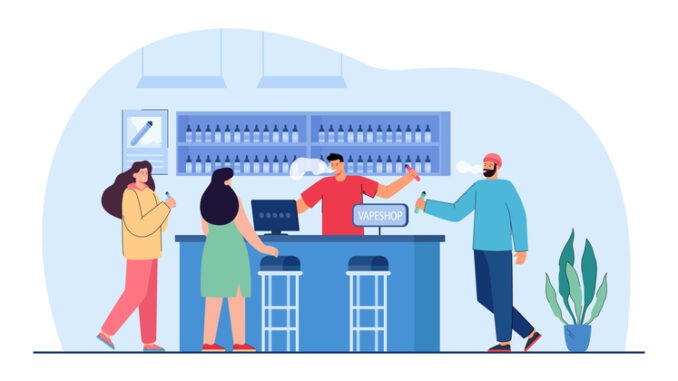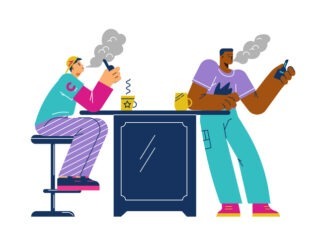
Michael Blaha explores whether vaping is really better than cigarettes
CREDIT: This is an edited version of an article that originally appeared on Hopkins Medicine
Vaping is less harmful than smoking, but it’s still not safe
E-cigarettes heat nicotine (extracted from tobacco), flavourings and other chemicals to create an aerosol that you inhale. Regular tobacco cigarettes contain 7,000 chemicals, many of which are toxic. While we don’t know exactly what chemicals are in e-cigarettes, Blaha says, “There’s almost no doubt that vaping exposes you to fewer toxic chemicals than smoking traditional cigarettes.”
However, there has been an outbreak of lung injuries and deaths (in America)associated with vaping. In February 2020 the Centers for Disease Control and Prevention (CDC) confirmed 2,807 cases of e-cigarette or vaping use-associated lung injury (EVALI) and 68 deaths attributed to that condition. “These cases appear to predominantly affect people who modify their vaping devices or use black market modified e-liquids; this is especially true for vaping products containing THC,” explains Blaha.
The CDC has identified vitamin E acetate as a ‘chemical of concern’ among people with EVALI. Vitamin E acetate is a thickening agent often used in THC vaping products, and it was found in all lung fluid samples of EVALI patients examined by the CDC. The CDC recommends that people:
- Do not use THC-containing e-cigarettes or vaping products.
- Avoid using informal sources, such as friends, family or online dealers to obtain a vaping device.
- Do not modify, or add any substances to, a vaping device that are not intended by the manufacturer.
Research from the Johns Hopkins University on vape ingredients, published in October 2021, reveals thousands of chemical ingredients in vape products – most of which are not yet identified. Among those the team could identify were several potentially harmful substances, including caffeine, three chemicals never previously found in e-cigarettes, a pesticide and two flavourings linked with possible toxic effects and respiratory irritation.
Research suggests vaping is bad for your heart and lungs
Nicotine is the primary agent in both regular cigarettes and e-cigarettes, and it is highly addictive. It causes you to crave a smoke and suffer withdrawal symptoms if you ignore the craving. Nicotine is a toxic substance. It raises your blood pressure and spikes your adrenaline, which increases your heart rate and the likelihood of having a heart attack.
Is vaping bad for you? There are many unknowns about vaping, including what chemicals make up the vapor and how they affect physical health over the long term. “People need to understand that e-cigarettes are potentially dangerous to your health,” says Blaha. “Emerging data suggests links to chronic lung disease and asthma, as well as associations between dual use of e-cigarettes and smoking with cardiovascular disease. You’re exposing yourself to all kinds of chemicals that we don’t yet understand and that are probably not safe.”
Electronic cigarettes are just as addictive as traditional ones
Both e-cigarettes and regular cigarettes contain nicotine which, research suggests, may be as addictive as heroin and cocaine. What’s worse, says Blaha, many e-cigarette users get even more nicotine than they would from a combustible tobacco product: Users can buy extra-strength cartridges, which have a higher concentration of nicotine, or increase the e-cigarette’s voltage to get a greater hit of the substance.
Electronic cigarettes aren’t the best smoking cessation tool
Although they’ve been promoted as an aid to help you quit smoking, e-cigarettes have not received Food and Drug Administration (FDA) approval as smoking cessation devices. A recent study found that most people who intended to use e-cigarettes to kick the nicotine habit ended up continuing to use both traditional and e-cigarettes. In light of the EVALI outbreak, the CDC advises people who use e-cigarettes for smoking cessation to weigh the risks and benefits and first consider the use of other FDA-approved smoking cessation options.
A new generation is getting hooked on nicotine
Among young people e-cigarettes, especially the disposable kind, are more popular than any traditional tobacco product. According to Blaha, there are three reasons why e-cigarettes may be particularly enticing to young people. Firstly, many teenagers believe vaping is less harmful than smoking. Secondly, e-cigarettes have a lower per-use cost than traditional cigarettes. Finally, youths and adults find the lack of smoke appealing – with no smell, e-cigarettes reduce some of the stigma of smoking.
“What I find most concerning about the rise of vaping is that people who would never have smoked otherwise, especially young people, are taking up the habit,” says Blaha. “It’s one thing if you convert from cigarette smoking to vaping; it’s quite another thing to start up nicotine use through vaping – and getting hooked on nicotine often leads to the use of traditional tobacco products, down the road.”
Research from the CDC shows that vaping among young people has declined somewhat since 2020; it’s thought that being stuck at home under their parents’ supervision during the COVID-19 pandemic could have contributed to that trend.
However, Blaha says, interpreting the data is tricky, since young people change their preferences often and, when surveyed, may not consider using disposable products such as ‘puff bars’ as vaping. The same CDC report says disposable e-cigarette use has increased 1,000% among high school students, and 400% among middle school students, since 2019.
Vaping and the COVID-19 pandemic
Blaha points out that, when the pandemic first began, data show that e-cigarette sales went down, possibly because people were spending more time at home and avoiding stores and public areas – but he sees a trend that concerns him; rising rates of daily e-cigarette use among all vape users. “The number of people who vaped daily used to be one-in-five; now it’s up quite a bit, which is concerning because it implies more nicotine addiction. I’m keeping a close eye on that.”


Be the first to comment